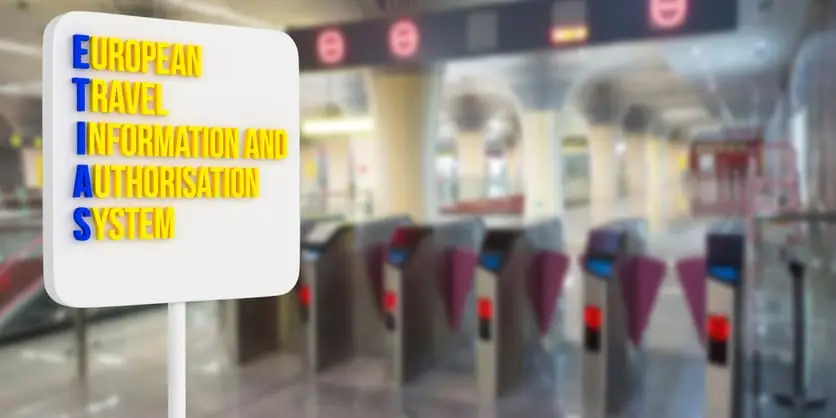At a glance: From late 2026, UK travellers will need to apply for ETIAS (European Travel Information and Authorisation System) travel authorisation before visiting Spain and 29 other European countries.
Applications will cost €20 for adults aged 18–69, while travellers aged over 70 and under 18 are exempt from the fee. Each authorisation will be valid for 3 years (or until your passport expires) and will be linked automatically to your passport for smoother border checks.
What is ETIAS?
If you’ve heard talk about new EU travel rules and aren’t quite sure what they mean, you’re not the only one.
ETIAS, short for the European Travel Information and Authorisation System, is a new requirement being introduced by the EU for visitors from visa-exempt countries – including the UK. It’s expected to start in late 2026, and will apply when travelling to most European destinations such as Spain, France, Italy and Greece.
ETIAS isn’t a visa, but it works in a similar way. Before you travel, you’ll complete a short online form confirming your passport details and a few basic pieces of information about your trip. Once approved, your ETIAS will be linked automatically to your passport, so there’s no need to print or carry an extra document.
ETIAS, EES… What’s the difference?
There seem to be a lot of new travel terms being introduced lately – and it’s understandable if it all feels a bit much to keep up with. The Entry/Exit System (EES) is separate from ETIAS, though the two will work hand in hand once both are live.
EES will roll out first, on 12 October 2025, replacing the usual passport stamp with a quick fingerprint and facial scan. You’ll need to get these done at dedicated kiosks at the airport prior to departure. Your details will then be stored digitally, so future crossings should be faster.
ETIAS, which launches later in 2026, will build on that system by carrying out simple checks before you travel.
When does ETIAS start for UK travellers?
ETIAS is expected to launch in late 2026, with a short grace period before it becomes fully mandatory in 2027. The exact date hasn’t been confirmed yet, but travellers will be given plenty of notice once applications open.
If you’re planning a holiday in 2025 or early 2026, nothing will change just yet. You won’t need to apply for ETIAS, and you can travel as normal using your UK passport.
How to apply for ETIAS
You can’t apply for ETIAS just yet. When the system launches, you’ll apply online using the official ETIAS website or the ETIAS mobile app.
You’ll need your passport, a payment card for the fee (if it applies to you – see the next section below), and a few personal details such as your name, address and travel plans. The form will also ask a handful of short questions about your background, such as previous travel and any security-related matters.
If there’s a delay or extra information is needed, you’ll be notified by email and given guidance on what to do next.
How much does ETIAS cost?
When ETIAS launches, most adult travellers will pay a €20 fee when completing their application. The payment covers 3 years of travel across the 30 European countries taking part in the scheme.
Who doesn’t have to pay?
If you’re aged 70 or over, you won’t need to pay the €20 fee to get ETIAS approval. The same exemption applies to travellers under 18, and to family members of EU citizens or residents who have the right to move freely within Europe.
You’ll still need to fill in the short online form before you travel, but the application itself will be free. This means many regular travellers can keep exploring Europe just as they always have without any added cost.
How long is ETIAS valid for?
Once approved, your ETIAS will be valid for 3 years, or until your passport expires – whichever comes first. That means you won’t need to reapply every time you travel.
During that 3-year period, you’ll be able to visit any of the 30 European countries that use ETIAS for short stays of up to 90 days within any 180-day period.
If your passport expires sooner, you’ll need to apply for a new ETIAS once you have your new passport. The authorisation is linked electronically to your passport, so it can’t be transferred between documents.
What else should I check before travelling to Europe?
If you’re already thinking about your next trip, there’s no need to change your travel plans because of ETIAS just yet. But it’s always worth checking a few basics before you go:
- Start with your passport. Make sure it’s less than 10 years old and has at least 3 months left from the date you plan to return home. ETIAS approval will be linked to your passport, so it’s a good idea to renew early if it’s close to expiring.
- Keep an eye on official updates from the European Union or the UK Government. Once the ETIAS website and app are live, they’ll share clear guidance on how and when to apply. Avoid unofficial websites that claim to offer early access – these may charge unnecessary fees or turn out to be unreliable.
- Check Foreign, Commonwealth & Development Office (FCDO) advice for your destination before you travel, especially if you’re visiting new areas.
- Make sure you’ve thought about getting the right travel insurance. ETIAS might get you across the border, but travel insurance is what can protect you before and during your trip, from cancellations to medical emergencies.




